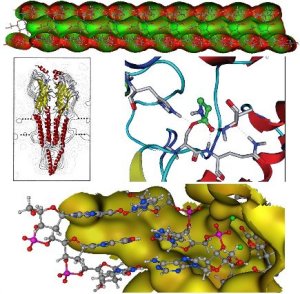Research & Facilities
During the active days of my research group, we were interested in a functional understanding of biological macromolecules and in the control of molecular processes. Our methodology was based on computational techniques like molecular modeling, QM/MM-methods, and molecular dynamics procedures. Together with various cooperating experimental research groups, we applied a synergistic approach toward the investigation of functional (bio)polymers.
Top: Longitudinal section through an amylose helix showing the glucose units in the foreground and the inner helix surface in the rear. Middle left: Side view of an acetylcholine receptor model. Middle right: Reaction intermediate of lipase catalyzed beta-lactam polymerization with Ser105-bound lactam. Bottom: Detail view of RNAse-H protein looking at the RNA segment in the active site.
Our research projects involved:
- The neurotransmission at the cholinergic synapse, which is closely related to Alzheimer’s dementia. In this project, we investigate e.g. structure and function of the acetylcholine receptor and the acetylcholinesterase
- The study of self-organizing processes toward new nanostructure material from amylose inclusion-complexes. These investigations involved e.g. complexes of amylose with synthetic polymers or the utilization of inclusion complexes as medicinal carrier systems.
- The investigation of polycondensation reactions, where our focus was on the lipase-catalyzed synthesis of polyesters and polyamids.
- The elucidation of molecular processes involved in RNA-cleavage by ribonucleases using DFT-based QM/MM-methods.
As a further aspect, we have looked into digitally assisted teaching and learning methods with particular emphasis on E-learning materials for organic chemistry.


